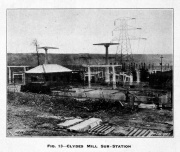Central Scotland Electricity Scheme: Difference between revisions
No edit summary |
No edit summary |
||
| Line 13: | Line 13: | ||
* [[Portobello Power Station]] | * [[Portobello Power Station]] | ||
* [[Dalmarnock Power Station]] | * [[Dalmarnock Power Station]] | ||
* [[Stonebyres Power Station|Stonebyres]] [[Corra Linn Power Station]] | * [[Stonebyres Power Station|Stonebyres]] and [[Corra Linn Power Station]]s | ||
A further 4 stations would be retained temporarily: | |||
* [[Bonnybridge Power Station]] | * [[Bonnybridge Power Station]] | ||
* [[Carolina Port Power Station]] | |||
* [[Dunfermline Power Station]] | * [[Dunfermline Power Station]] | ||
* [[Kilmarnock Power Station]] | * [[Kilmarnock Power Station]] | ||
Latest revision as of 08:49, 17 January 2025



.


1927 The Central Scotland scheme was the first scheme proposed to the Central Electricity Board for linking up the national electricity network; it affected c.5000 sq.miles of central Scotland. Out of the existing 36 generating stations in the area, 10 would be retained, to be reduced eventually to 6, 2 of which would be extended (at Dalmarnock and Portobello) and 2 new ones built; a series of high voltage transmission lines would be constructed to link up the various undertakings; the frequency of the alternating current would be standardised at 50 cycles/second.[1]
The selected stations were:
- Yoker Power Station
- Port Dundas Generating Station
- Clyde's Mill Power Station
- Portobello Power Station
- Dalmarnock Power Station
- Stonebyres and Corra Linn Power Stations
A further 4 stations would be retained temporarily:
- Bonnybridge Power Station
- Carolina Port Power Station
- Dunfermline Power Station
- Kilmarnock Power Station
See Also
Sources of Information
- ↑ The Times, May 11, 1927

